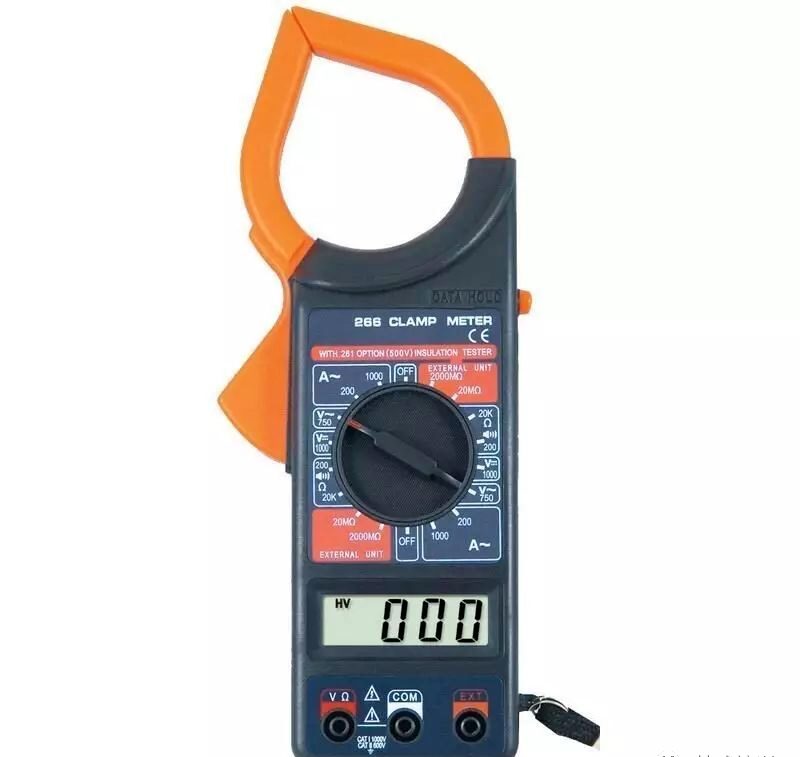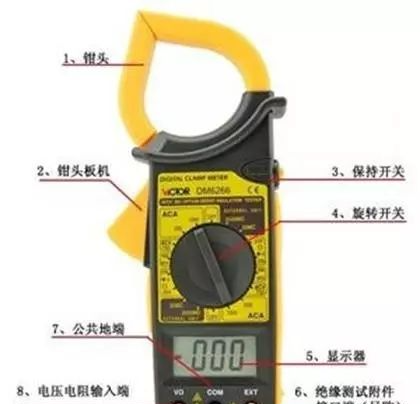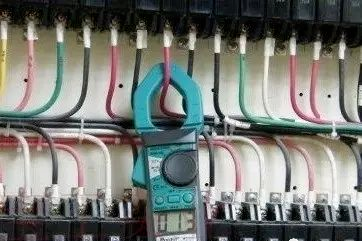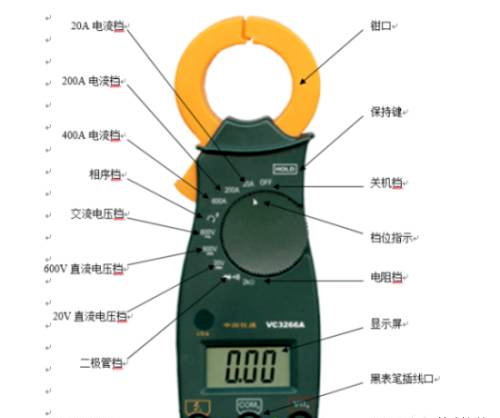

The clamp ammeter is composed of a current transformer and an ammeter. The core of the current transformer can open when the clamp is tightened; the wire carrying the current to be measured can pass through the open gap of the core without being cut. When the clamp is released, the core closes.

The clamp ammeter is composed of a current transformer and an ammeter. The core of the current transformer can open when the clamp is tightened; the wire carrying the current to be measured can pass through the open gap of the core without being cut. When the clamp is released, the core closes.
When we need to measure current without breaking the circuit, we need to use a clamp ammeter (sometimes referred to as a clamp meter). A clamp ammeter is an instrument used to measure the current in an operating electrical line and is a common tool for electricians. Clamp ammeters are divided into two main categories: clamp AC ammeters and clamp AC/DC ammeters, with some also able to measure AC voltage.
Structure:

The clamp AC ammeter is essentially composed of a current transformer and a rectifier-type meter. The wire carrying the current to be measured acts as the primary winding of the current transformer, while the secondary winding of the current transformer is on the core, connected to the rectifier-type meter. Based on a certain proportional relationship between the primary and secondary windings of the current transformer, the rectifier-type meter can display the current value of the measured circuit.
The clamp AC/DC meter is an electromagnetic-type instrument, with the wire being measured placed in the clamp acting as the excitation coil. The magnetic flux forms a loop in the core, and the electromagnetic measuring mechanism is located in the gap of the core, deflected by the magnetic field to obtain a reading. Since its deflection is not affected by the measured current, it can measure both AC and DC currents.
Usage Method:

The usage method of the clamp ammeter is simple. As shown in the figure above, to measure current, simply clamp the wire to be measured into the core of the clamp ammeter, and then read the value on the display screen or indicator dial.
It’s quite simple, right? Just clamp the measuring wire. However, with the widespread use of digital clamp ammeters, many multimeter functions have been added to clamp meters, such as voltage, temperature, resistance, etc. (sometimes referred to as multifunction clamp meters, as shown in the figure above, the instrument has two probe sockets), and different functions can be selected using the knob, which is similar to using a general digital multimeter. For the meanings of some specific function buttons, refer to the corresponding manual.

Phase Sequence Testing:
(1) Turn the dial to the phase sequence detection gear;
(2) Insert the probes yellow, black, and red into the c, COMb, VΩa sockets in order;
(3) Connect the red, black, and yellow probes to A, B, C (or L1, L2, L3) respectively. When connecting the red and black probes, the indicator light glows faintly, and when the yellow probe is connected, the indicator light is on, indicating a positive phase sequence; if the indicator light is off, it indicates a negative phase sequence;
(4) The phase sequence gear can also measure phase-to-phase voltage.
AC Voltage Measurement:
(1) Turn the dial to the AC voltage gear;
(2) Insert the red and black probes into the VΩa, COMb sockets;
(3) Connect the other end of the red and black probes to the point to be measured, and read the value.
AC Current Measurement:
(1) Select the appropriate current gear;
(2) Fully clamp the wire to be measured with the clamp, and read the data;
Note: The maximum test current for this instrument is only 600A; do not test currents exceeding 600A.
DC Voltage Measurement:
(1) Select the appropriate DC voltage gear;
(2) Insert the red and black probes into the VΩa, COMb sockets;
(3) Connect the other end of the red and black probes to the point to be measured, and read the value.
Resistance Measurement:
(1) Turn the dial to the resistance gear 2kΩ;
(2) Insert the red and black probes into the VΩa, COMb sockets;
(3) Connect the other end of the red and black probes to the point to be measured, and read the value;
Note: Resistance can only be tested when the power is off.
Line Continuity Measurement:
(1) Turn the dial to the diode gear.
(2) Insert the red and black probes into the VΩa, COMb sockets.
(3) Connect the other end of the red and black probes to the point to be measured, and read the value. If the value is very small and the multimeter emits a “beep” sound, the circuit is continuous; conversely, if the value displays “1” and the multimeter does not sound, the circuit is open or has a very high resistance.
Note: Resistance can only be tested when the power is off.
(1) Before using a digital multimeter, carefully read the user manual to familiarize yourself with the power switch function, range switch, input sockets, probe uses, and the functions of various keys, knobs, and accessories. Additionally, understand the limit parameters of the multimeter, including overload display, polarity display, low voltage display, and other indicators and alarms, as well as the rules for the position of the decimal point. Before measuring, carefully check the probes for cracks, the insulation of the leads for damage, and whether the probes are inserted correctly to ensure the safety of the operator.
(2) Before each measurement, double-check the measurement item and range switch to ensure they are set correctly, and that the input socket (or dedicated socket) is selected correctly.
(3) When measuring, the instrument may show fluctuations; wait for the displayed value to stabilize before reading.
(4) Although the digital multimeter has a relatively complete protection circuit, try to avoid operational errors, such as measuring voltage with the current range, measuring voltage or current with the resistance range, or measuring a charged capacitor with the capacitance range, to prevent damage to the instrument.
(5) If only the highest position shows the number “1” while other positions are blank, it indicates the instrument has experienced an overload; select a higher range.
(6) Do not switch the range switch while measuring voltage above 10OV or current above 0.5A to avoid arcing and burning the contacts of the switch.
(7) The numbers next to the danger mark on the input socket represent the limit values for voltage or current input for that socket. Exceeding these limits may damage the instrument or even endanger the operator’s safety.
(8) Clamp multimeters should not be used to measure current on high-voltage lines; the voltage of the measured line must not exceed the voltage level specified for the clamp meter (generally not exceeding 500 volts) to prevent insulation breakdown and electric shock.
(9) Estimate the size of the current to be measured and select the appropriate range; do not use a small range to measure large currents.
(10) Before measuring, ensure the range switch is set to the corresponding AC current range; do not use the voltage or resistance range to measure current.
Remember! Never use the resistance range and current range to measure voltage; doing so may damage the meter.
(11) Only one wire can be clamped during each measurement. When measuring, the wire to be measured should be positioned in the center of the clamp to improve measurement accuracy. It is best to hold the instrument level with your hand to prevent the wire from touching the clamp and the instrument body.
(12) After measuring, the range switch must be turned to the maximum voltage range before turning off the power switch to ensure safe use next time.